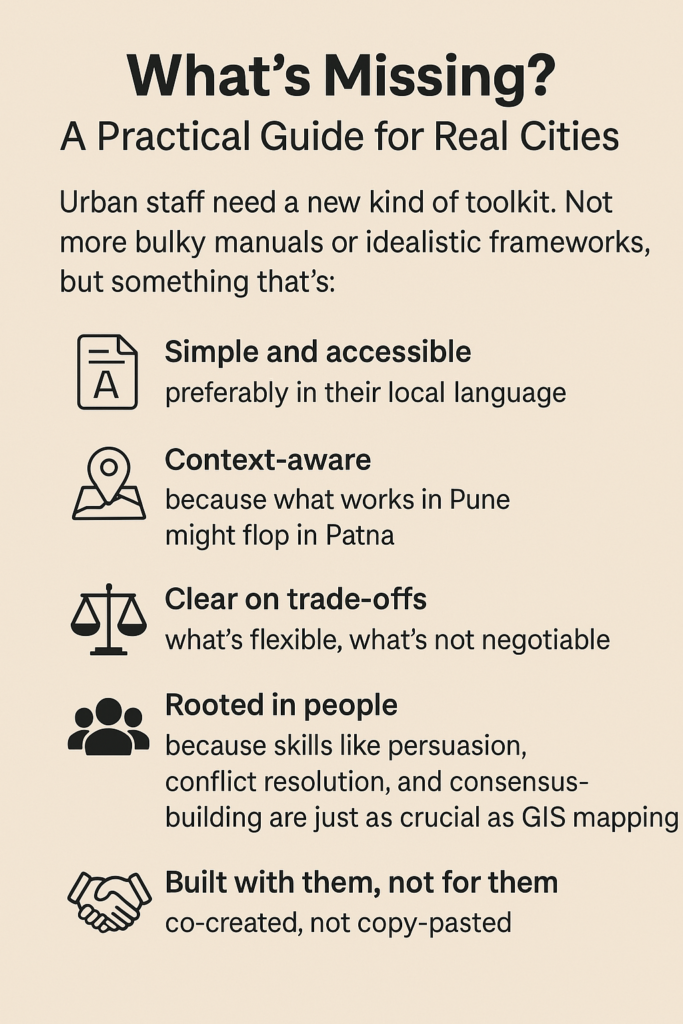experts, meet doers: why india’s urban future needs both wheels of the cart

Every few months, a new buzzword pops up in the world of urban planning — climate-resilient cities, child-friendly neighbourhoods, walkability, zero waste, low-emission zones, and the list goes on in name of India’s urban future.
There’s no shortage of expert groups, think tanks, NGOs, and agencies eager to build better cities. Workshops, conferences, capacity-building programs, MoUs — they’re happening everywhere. On paper, it looks like we’re gearing up for an urban revolution.
But here’s the question no one asks enough: Do the people running our cities understand any of this?
Who’s Holding the Steering Wheel?
Let’s zoom in a bit. The average municipal engineer or city staffer in India isn’t just managing roads and drains. They’re also setting up vaccination booths, arranging lights for Ganesh visarjan, handling election logistics, responding to disasters, and occasionally, helping organise cricket matches. Urban development? That’s just one part of their massive to-do list. Can we expect them to keep pace with the latest urban theories, tech tools, and international best practices? The reality is — they can’t. Not alone.
So, they fall back on codes, standards, and guidelines. Which is great for ticking boxes. But rigid rulebooks don’t always help with real-world messiness to address India’s urban future.
It Takes Two to Build a City
This is where experts need to stop handing over reports and start rolling up their sleeves. Imagine if planners, consultants, and researchers worked within city offices, not just as advisors who fly in and out, but as long-term partners. People who sit beside the doers, helping them interpret what a “child-friendly” street means for a local ward officer with a tight budget and tighter deadlines.

Could we have technical experts embedded in municipal teams? Could they translate complex ideas into doable actions?
What’s Missing? A Practical Guide for Real Cities
Urban staff need a new kind of toolkit. Not more bulky manuals or idealistic frameworks, but something that’s:

- Simple and accessible – preferably in their local language
- Context-aware – because what works in Pune might flop in Patna
- Clear on trade-offs – what’s flexible, what’s not negotiable
- Rooted in people – because skills like persuasion, conflict resolution, and consensus-building are just as crucial as GIS mapping
- Built with them, not for them – co-created, not copy-pasted
Right now, most planning documents assume that cities run like software, input data, press enter, and get outcomes. But cities are not coded. They’re chaotic, messy, and deeply human.
The Urban Dysfunction Loop
When experts stay in their bubbles and staff stay stuck in outdated rules, nothing changes. We go round in circles — potholes, pollution, floods, rising heat, unsafe streets, unaffordable housing, and poor planning.
And then comes the glossy report, the shiny presentation, and a polished video saying, “Look, we’re transforming cities!” Are we, though?
Time to Walk Together
We don’t need more buzzwords. We need better bridges between those who know and those who do. If India wants cities that are truly inclusive, resilient, and liveable, we need both experts and doers pulling together — like two wheels of a cart. One without the other? You’re going nowhere.
No more. No less. Period.
This 4th article is part of a series exploring the paradoxes of Indian urban planning and seeking possible solutions. Read 1st article here, 2nd here & 3rd.

One thought on “Experts, Meet Doers: Why India’s Urban Future Needs Both Wheels of the Cart”